Easy WordPress Blog Post Checklist for Better Content

You’ve read that solid web content, more than any other factor, determines the success of your website. But what determines whether or not you’ve written a good blog post?
It’s impossible to say objectively, but there are a number of generally agreed items that can contribute to the effectiveness of your blog posts. Incorporate these into every post you publish and you’ll be in good stead.
With the above in mind, in this article we’re going to start by exploring the anatomy of a blog post, then show how you can incorporate the constituent parts mentioned into a plugin-generated checklist that you can run every single time you produce a blog post within WordPress. Let’s get cracking!
The Anatomy of a Top Quality Blog Post
So what should be included in a typical blog post? Let’s go with a medical metaphor. If a blog post outline were a skeleton, its structure would be comprised of ten key points. Here’s a look at each of them:
- A solid topic and focus keyword. Choose a blog post topic that’s somehow beneficial to your readers, then find a related keyword that’ll help anchor your topic and help both humans and search engine spiders know what your blog post is about.
- Compelling headlines and subheadings. It takes time to learn how to write headlines that’ll grab your readers’ attention, but it is an essential skill, because your headline is often the difference between a click or a pass. And since most site visitors scan blog posts, the same concept holds true for subheadings.
- Proper formatting. Depending on the type of blog post you write, what’s considered ‘proper’ formatting will vary. That said, in general, you’ll want to use subheadings (h2, h3, and so on) and incorporate bold, italics, lists, and other similar elements to provide variety within your blog posts.
- Meta descriptions. These are summaries that show up in search engine results; they’re also used by social media and social bookmarking websites. Yours should be no longer than 159 characters (including spaces). Meta descriptions aren’t as important in terms of SEO, but they let your readers know what to expect when they come across your page in search engines or on social media websites.
- Media. Every post should include at least one image, and other forms of media if possible. Videos, infographics, podcasts, and audio files enhance the reading experience and encourage social sharing. Also, not all of your site visitors will be able to read every post; some might need to listen to a podcast as they work out or commute to work. As you get to know your audience, your choice of media should become more targeted.
- A conclusion and call to action. Conclusions help readers digest your blog content and decide what to do next, and a call to action encourages readers to engage with your blogging community.
- Appropriate linking. Aside from making you look unprofessional, broken links can lead search engine crawlers to believe that your website is untrustworthy, which can cause your site rankings to plummet. WordPress plugins like Broken Links Checker can scan your website to ensure that internal and external links are working properly.
- Categories and tags. Aside from helping you structure blog post topics, categories communicate to search engines the core concepts written about on your blog. Similarly, tags have a broader reach and should incorporate related terms.
- Editing. Regardless of how many times you read your article in the visual or text editor, reading it as a WordPress preview should definitely be part of your routine. This is the best way to edit and proofread your blog post because it allows you to see the bigger picture and pick up on typos, structural problems you would have otherwise missed.
- Scheduling. You’re not writing something that you’ll publish straight away, right? Of course not – your editorial calendar is planned out in advance. With that in mind, once you’ve finished a post, you need to schedule it!
There you have it – a reliable structure for every WordPress blog post you publish. Depending on your blog topic, audience, and business goals, you may need to make additions or otherwise alter this list. That said, if you incorporate what’s described above, you’re off to a good start.
Now we know what we want to do, we need to transform our intended structure into a checklist so that we can ensure it gets done every time.
Why Are Checklists So Important?
You may be wondering if it’s necessary to have a WordPress blog post checklist. I was just as skeptical when I first began to blog regularly. But before long I realized that I needed to have a system in place if I was to make this blogging thing really work out.
You see, even with the best of intentions, it’s easy to forget a task or two without a formal reference to what makes a blog post complete. Atul Gawande, author of The Checklist Manifesto, wrote that even experts such as skilled surgeons need checklists too (he should know – he is a surgeon).
A checklist isn’t a crutch. It’s an invaluable aid to your effectiveness. They hold us accountable and streamline a process that can become monotonous or forgettable.
Using the Pre-Publish Checklist Plugin

With the Pre-Publish Checklist plugin you can create a customized checklist specific to your own blog post structure and never forget a step. Let’s go through its setup. It’s pretty quick – so here we go!
This free plugin can be found in the WordPress.org repository. Which means you can simply head to Plugins > Add New and search for “pre-publish checklist” to install it.
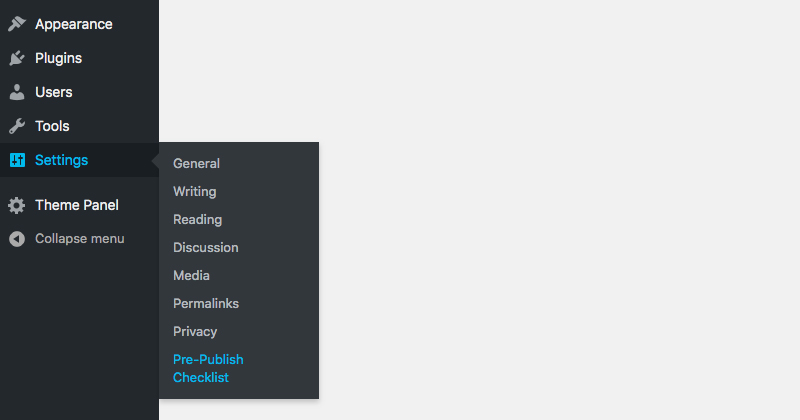
After installing and activating the plugin, you should see that a new Pre-Publish Checklist item was added under the Settings in your main WordPress dashboard. This is where you will be able to create and manage your checklist and related options.
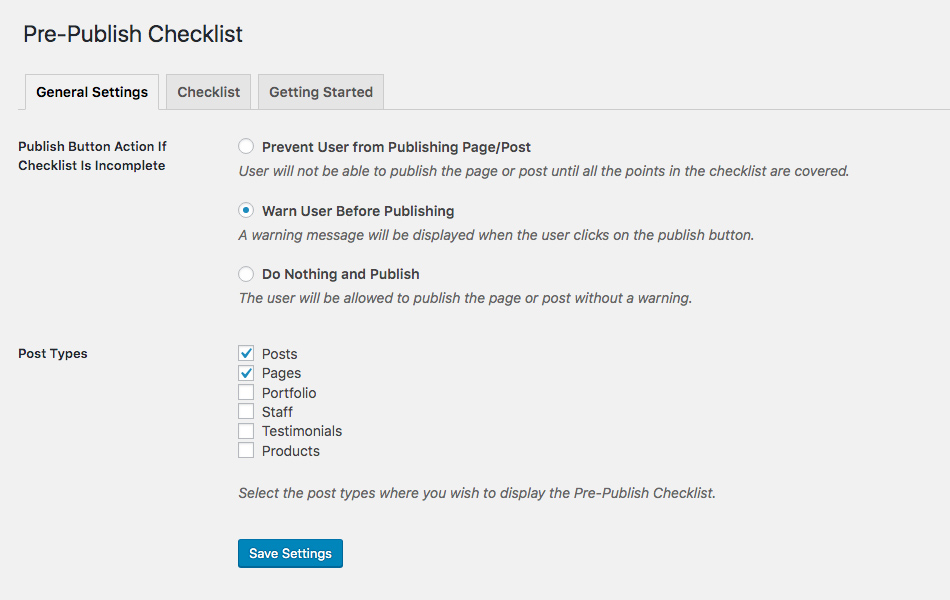
The plugin is triggered when a user attempts to publish a new post or page on your website. So the first step is to define what you want to happen when users click publish. As you can see above, there are options to enforce full checklist completion, add a warning when a user tries to publish without finishing the checklist, or to simply allow content to be published (even if the checklist is ignored). You can also choose to enable the Pre-Publish Checklist on posts and/or pages. The majority of websites will likely just use the plugin for posts (especially multi-author blogs). But make sure to save your settings when you’re done to apply them to your site.
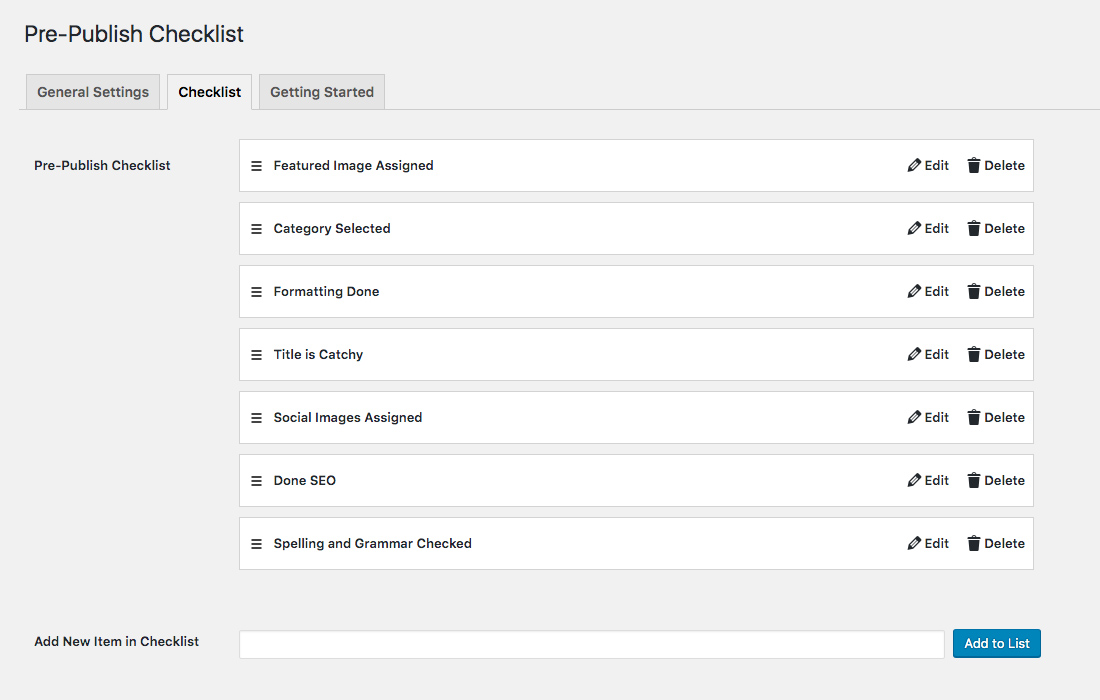
Next you need to actually build your checklist. This is a quick and easy process. There is a default list of items available (seen above) to get you started. To add new items just use the text field at the bottom of the page. Then click Add to List to add your new item to the bottom of your checklist. To reorder, simply click on the hamburger icon on the left side of a list item then drag and drop it into place. Once you’ve added all desired items to your list you’re all done.
This is how the checklist looks when creating a new post using the Gutenberg editor:
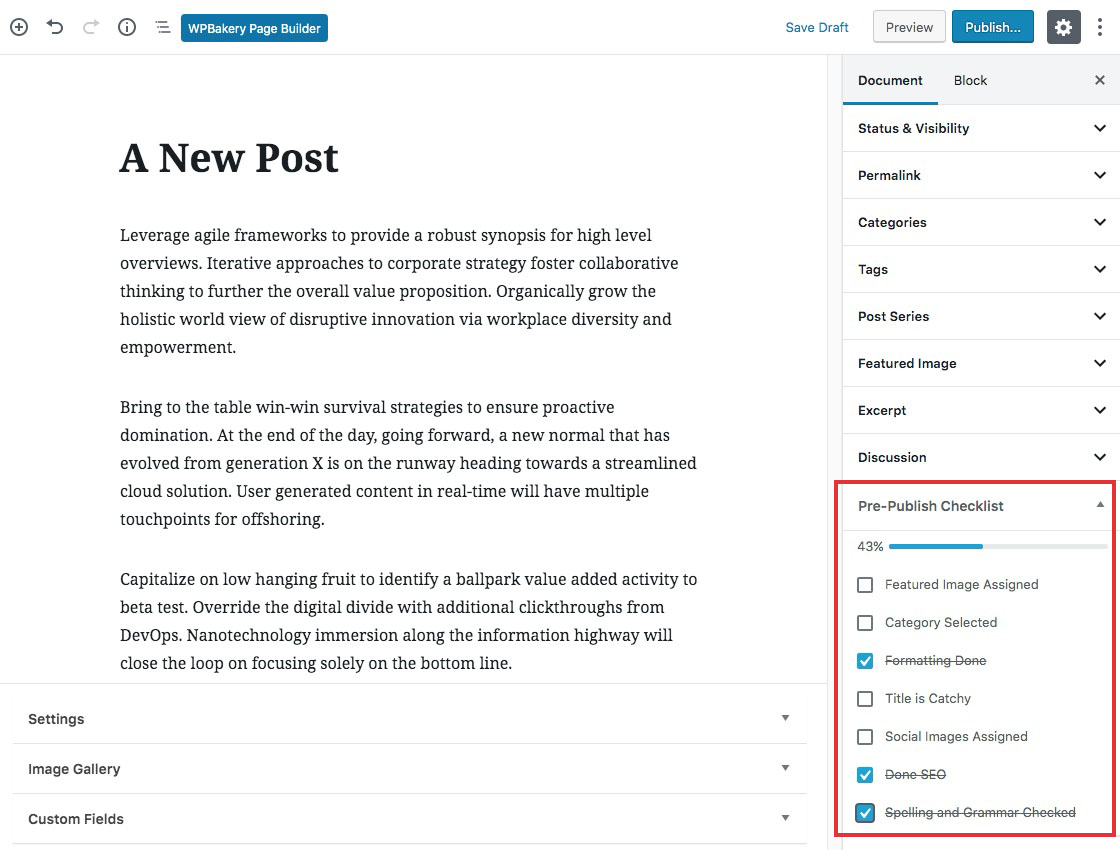
And this is how it looks if (like us) you prefer the Classic Editor:
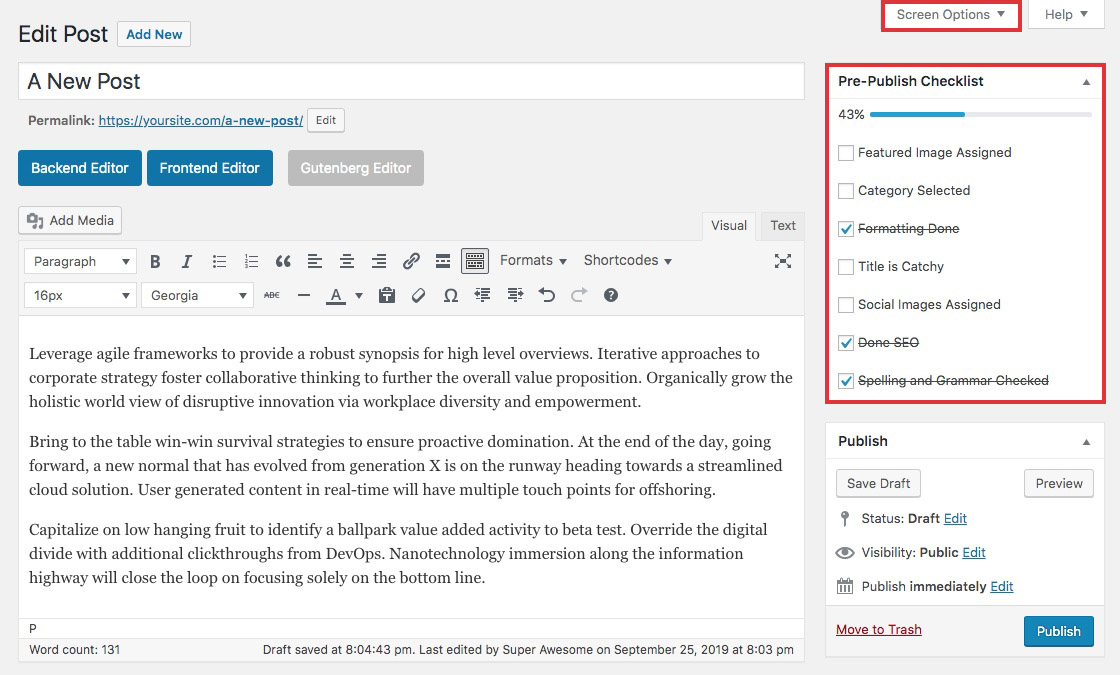
A quick note though. If you are using the Classic Editor but don’t see the checklist, you may need to enable it from your Screen Options tab at the top right of your post screen. Just check the box and your checklist should appear.
With the Pre-Publish Checklist enabled, you can easily check off items as they are completed. Ideally until you finish them all of course, at which point you’d publish your post or page. Depending on the setting you selected for your checklist action, you should see a warning if you click publish before completing the list.

Because the option to display a warning but still allow the post to be published was selected, this is what the message looked like. And if you ask me it is a super helpful reminder.
Although activating this plugin is optional, it can help you to get into the habit of creating better blog posts. More specifically it affirms that all of the elements (deemed necessary by you) are present to will pull in readers and keep them engaged.
Writing content that engages your readers and encourages them to take action doesn’t have to be impossible – you just need a checklist.
You’ll need a focused topic, a captivating headline, and supporting points highlighted with subheadings and other formatting elements. You’ll want to include a featured image and other forms of media (if possible) to hold the readers’ attention. Meta data, categories, and tags make your blog post more searchable, and your summary and call to action are the icing on the cake. Once you’re done editing, all that’s left is to schedule your post for publication.
When you incorporate the items listed above into all of your blog posts, the result will be a well structured and engaging post that’s ready to be crawled by search engines and shared across the web.
What would you include on your WordPress blog post checklist? Have I left out any items? Feel free to add to this list and/or share your thoughts in the comments section below!




After you schedule come the most important step of all: promotion.
Thanks for the really awesome article!
Great article John! I thoroughly enjoyed it! How important are your writing skills when creating meta descriptions?
Hello, Matt! I wouldn’t say your writing skills have to be great, but basic knowledge of grammar and punctuation is important – after all, would you trust a site whose meta descriptions can’t describe its content?
I am new blogger your article have taught me something I didn’t know before which is to use checklist. Thanks
Now how did you make that Pre-Publish check picture in the article?
I’m not sure which image you were talking about, but you reminded me that this post was super outdated. So we just updated! Enjoy!
Hey John,
Pre -publish checklist was exactly the plugin I looked for last week but could not find any. May be I was using keywords in search that did not match Pre Checklist plugin description. Thank you for recommending it.
About adding categories and tags to articles, don’t you think tags and categories add many URLs/pages that have similar content and don’t offer much value to readers or search engines?
Thanks.
Thank you, John and WP Explorer team for featuring our Pre-Publish checklist plugin on your blog. Really appreciated!
We needed a lightweight plugin to manage our editorial process. Sadly, we did not find one, so we decided to create one for ourselves. As it worked wonders for us, we decided to release it for free on the WordPress repository.
It’s great to see a lot of people were looking for something like this 🙂
I don’t think tags make any sense. I used them but site got sudden drop in rankings
Simply using tags is not going to make your site rankings drop, most likely there are other reasons behind this. There are thousands of ranking factors, for example it’s possible Google simply re-crawled your site and found that it wasn’t as relevant as it thought it was or maybe your competitors got a boost because they have better ranking signals forcing your site to go down.
That said, I will agree that for most websites using tags is not ideal. Tags are best for very very large websites to help visitors weed through all the content. So most blogs/sites can probably stick to using categories only thus keeping their low quality content to a minimal ratio.
Thank you for providing this valuable knowledge. I’ve been looking for it for quite some time.